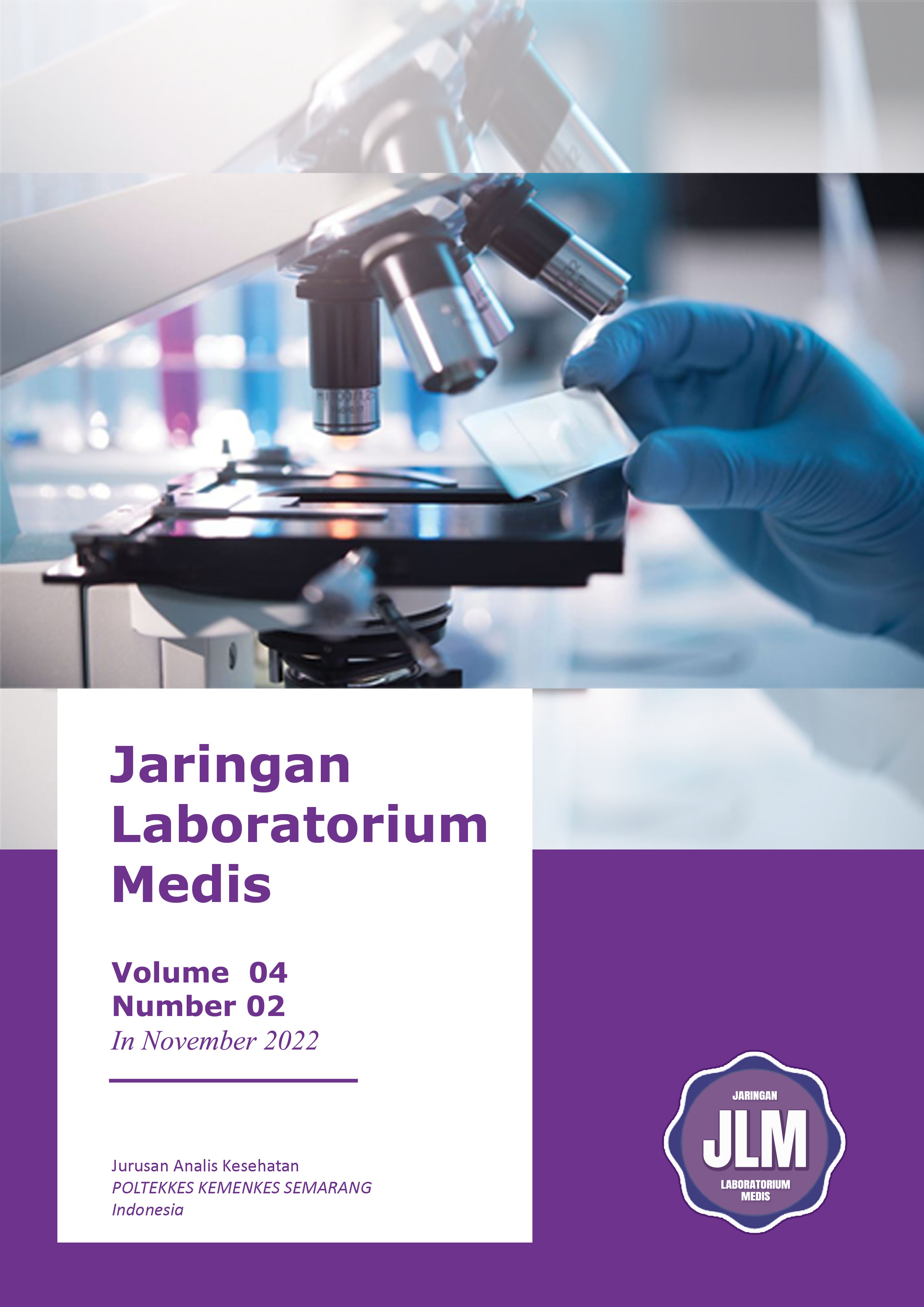Published 2023-12-07
Keywords
- Jamu Beras Kencur,
- The Number of Yeast Molds,
- Yeast Mold Identification
Copyright (c) 2022 Jaringan Laboratorium Medis

This work is licensed under a Creative Commons Attribution-ShareAlike 4.0 International License.
How to Cite
CrossMark
Dimensions
If it doesn't Appear, click here
Impact Factor
Abstract
During the Covid-19 pandemic, people began to maintain their health, by using herbal medicine as an alternative treatment. One type of herbal medicine used is jamu beras kencur because it has properties to increase stamina, increase appetite, and relieve aches and cough disorders. In the Regulation of the Minister of Health of the Republic of Indonesia No. 007 of 2012 carrying herbs such as jamu beras kencur does not require marketing authorization. The quality of the herbal medicine produced has not been confirmed as feasible from microbial contamination, especially in molds, the number of yeast molds in the jamu beras kencur must comply with BPOM standards Number 32 of 2019 namely AKK <103 colonies/mL. This study aimed to determine the effect of the storage time of jamu beras kencur on mold growth with storage treatments of 0 hours, 4 hours, 8 hours, 12 hours, and 24 hours at room temperature. This type of research is a Quasi Experiment with a research design of One Group Pretest-Postest Design. The results of this study showed that the average AKK value was 0 hours 0.2x100 colonies/mL, 4 hours 0.4x100 colonies/mL, 8 hours 0.4x100 colonies/mL. 12 hours 0.8x100 colonies/mL and 24 hours 2.2x100 colonies/mL. These results stated that the jamu beras kencur met the BPOM standard requirements Number 32 of 2019 which was AKK <103 Colonies/mL. The results of the Kruskal Wallis test obtained a sig value of 0.286, it was concluded that there was no effect of storage time for the jamu beras kencur on the growth of molds. The identification results on the jamu beras kencur obtained fungal species, namely Aspergillus flavus, Aspergillus niger, and Penicillium sp. Suggestions for further researchers can examine the effect of storage time on mold growth in other types of herbal medicine.
Downloads
References
- Agnis, F.R & Sri W. (2015). Gambaran Jamur Aspergillus flavus pada Bumbu Pecel Instan dalam Kemasan Tanpa Merk yang dijual di Pasar Gedong Tataan Kabupaten Pesawaran. Jurnal Analis Kesehatan, 4(2), 456-460
- Arifah, A. A. (2019). Gula Pasir Sebagai Pengganti Dektrosa Pada Komposisi Pda Untuk Efisiensi Biaya Praktikum Dan Penelitian Di Laboratorium Fitopatologi. Jurnal Temapela, 2(1), 28–32.
- Augustine, D., Sekar, B., & Murali, S. (2012). Invasive Aspergillosis of the maxilla-An unusual report. Jioh, 4(2), 47–52.
- Azara, R dan Ir. Ida Agustini Saidi. (2020). Buku Ajar Mikrobiologi Pangan. Sidoarjo: UMSIDA Press
- Bagus, I. G. N., Widaningsih, D. W. I., & Sudarma, D. A. N. I. M. (2017). Keragaman Jamur yang Mengkontaminasi Beras dan Jagung di Pasar Tradisional Denpasar. Agrotrop, 7(1), 89–98.
- Dewi, S.A., I Dewa A. (2016). Uji Angka Kapang-Khamir dan Identifikasi Salmonella spp pada Jamu Beras Kencur yang Dijual Di Pasar Sambilegi Maguwoharjo Depok Sleman Yogyakarta. Skripsi. Fakultas Farmasi. Universitas Sanata Dharma. Yogyakarta
- Hakim, L., Kurniatuhad, R., & Rahmawati. (2020). Karakteristik Fisiologis Jamur Halofilik Berdasarkan Faktor Lingkungan Dari Sumur Air Asin Di Desa Suak, Sintang, Kalimantan Barat. Bioma : Jurnal Biologi Makassar, 5(2), 227–232.
- Hasanah, U. (2017). Mengenal Aspergillosis, Infeksi Jamur Genus Aspergillus. Jurnal Keluarga Sehat Sejahtera, 15(2), 76–86.
- Kementerian Kesehatan RI. (2015). Pembuatan Jamu Segar Yang Baik dan Benar. Jakarta: Kementerian Kesehatan RI, 1–36.
- Kuiper-Goodman T. 1996. Risk assessment of ochcratoxin A: An update. Food. Addit. Contam. 13 (Suppl): 553-557.
- Monita, K, dkk. (2021). Pemeriksaan Angka Kuman, Kapang/Khamir Dan Identifikasi Bakteri Patogen Pada Jamu Beras Kencur di Pasar Tradisional Kota Surakarta. Journal On Medical Science, 8(2), 142-146.
- Peraturan Kepala Badan Pengawas Obat dan Makanan Republik Indonesia No. 32 Tahun 2019 Tentang Persyaratan Keamanan Dan Mutu Obat Tradisional.
- Peraturan Menteri Kesehatan Republik Indonesia Nomor 007 Tahun 2012 Tentang Registrasi Obat Tradisional.
- Peraturan Menteri Kesehatan Republik Indonesia Nomor 6 Tahun 2016 Tentang Formularium Obat Herbal Asli Indonesia.
- Ramli, N. M. Tafsir & A.D. Hasjmy. (2009). Pertumbuhan Optimum Penicillium spp. dan Cunninghamella spp. yang Diisolasi dari Pakan dan Efek Toksiknya pada Mencit (Mus musculus). Media Peternakan, 32(1), 40–46.
- Santika, F. Y., Marhamah, M., & Dinutanayo, W. W. (2021). Perbedaan Angka Kapang Khamir Pada Jamu Beras Kencur Gendong Di Pasar Tradisional Dengan Jamu Beras Kencur Kemasan Di Depot Jamu Kota Bandar Lampung. Jurnal Medika Malahayati, 4(3), 160–167.
- Singapurwa, N. M. A. S., & Candra, I. P. (2021). Antimicrobial activity of garlic and Kaempferia galanga on Aspergillus sp. growth isolated from sardine fish Pedetan. IOP Conference Series: Earth and Environmental Science, 824(1).
- Siregar, R.S., dkk. (2021). Analisis Hubungan Sikap dan Tingkat Pengetahuan terhadap Perilaku Masyarakat Kota Medan Mengonsumsi Jamu Tradisional di Masa Pandemi Covid – 19. Seminar Nasional Ke-V Fakultas Pertanian Universitas Samudra.
- Sukmawati, D., Wahyudi, P., Rahayu, S., Moersilah, M., Handayani, T., Rustam, K. Y., & Puspitasari, S. I. (2018). Skrining Kapang Aspergillus spp. Penghasil Aflatoksin pada Jagung Pipilan di Daerah Bekasi, Jawa Barat. Al-Kauniyah: Jurnal Biologi, 11(2), 151–162.
- Thearesti, C. C. (2015). Uji Angka Kapang/Khamir Dan Identifikasi Escherichia coli Dalam Jamu Kunyit Asam Dari Penjual Jamu Di Wilayah Ngawen Klaten. Universitas Sanata Dharma Yogyakarta, 1–103.

